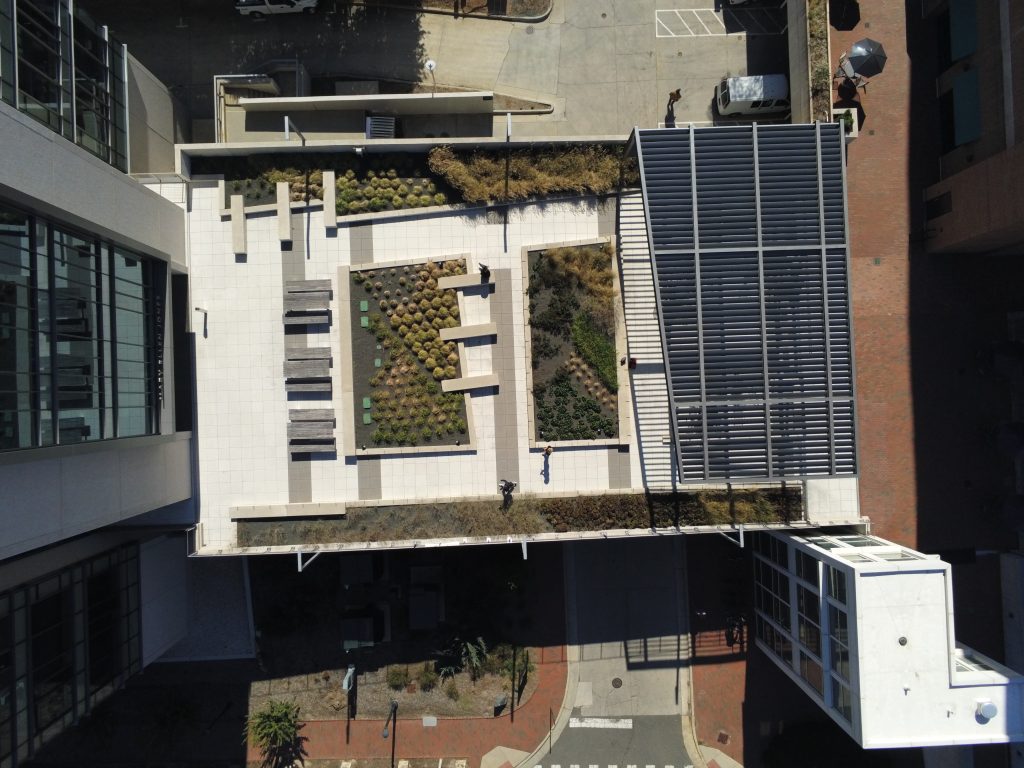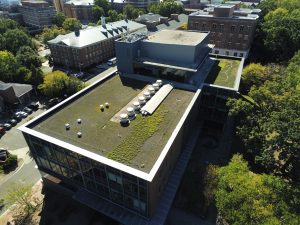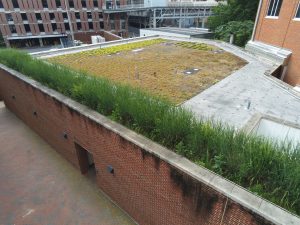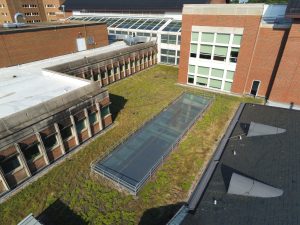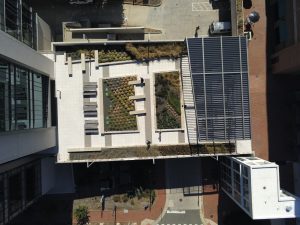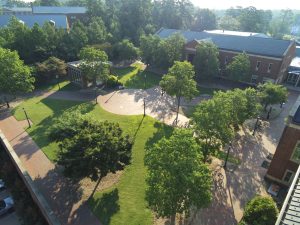Virtual Green Roof Tour at Carolina
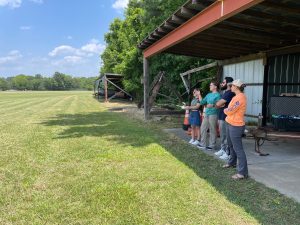 Islands in the Sky | Evaluating UNC-Chapel Hill’s Campus Green Roofs
Islands in the Sky | Evaluating UNC-Chapel Hill’s Campus Green Roofs
Carolina Drone Lab’s “Islands in the Sky” project is a collaboration among CARDNL, UNC Institute for the Environment, UNC Facilities Services and Sustainable Carolina. The project is made possible by the UNC Center for Faculty Excellence (CFE)/ Lenovo Instructional Innovation Grants program.
During the project, CARDNL gathered ground-based and aerial data to provide a complete picture of green roof performance and management practices. Because green roofs aid in stormwater management and increase green space in urban areas, they are a popular concept in modern green architecture.
Green Roofs at UNC-Chapel Hill
Green roofs retain 70% of the rainwater that falls on them, easing stress on stormwater systems during heavy storms. They reduce noise pollution and are aesthetically pleasing, providing a sense of nature in more urban areas. Green roofs also enhance biodiversity and improve air quality.
UNC-Chapel Hill got its first green roof in 2005, on the top of Carrington Hall. Since then, seven more have been built on campus. The most well-known and accessible roof is the Fed Ex Global Education Center’s green roof, constructed in 2007.
The Islands in the Sky project aimed to accomplish three things:
- Shine a light on innovative installations.
- Promote green infrastructure.
- Test the use of drone technology to monitor plant health on green roofs.
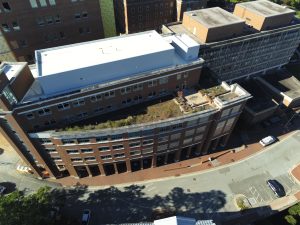 The green roof sits on the fourth floor of UNC’s School of Nursing. Installed in 2005, it has a total planted area of 2,860 square feet and a 6 inch soil depth. Rain water that falls on this green roof drains into the nearby stormwater system. In the afternoon, vegetation on the roof receives some shade.
The green roof sits on the fourth floor of UNC’s School of Nursing. Installed in 2005, it has a total planted area of 2,860 square feet and a 6 inch soil depth. Rain water that falls on this green roof drains into the nearby stormwater system. In the afternoon, vegetation on the roof receives some shade.
To access this roof, take the Carrington Hall elevator to the fourth floor. Exit the elevators and go through the glass door. During the day, you may find students, faculty and staff taking a break to enjoy the roof and some of the local art on display.
[/row]Designed by the renowned Leers Weinzapfel Associates, the FedEx Global Education Center boasts an 11,420 square foot green roof. Installed in 2007, soil depth on this roof ranges from 5.25 to 6 inches. The plant contains drought-resistant plants such as sedum and delosperma. A wall on the eastern side of the roof casts shadows in the morning and late afternoon. To access this roof, enter the FedEx Global Education Center, go past the information desk and turn left toward the elevators. Take the elevator to the fourth floor and the green roof will be straight ahead, through the glass doors.
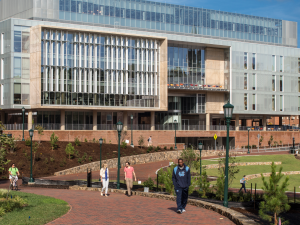
The Genome Sciences Building hosts two green roofs. The upper green roof, installed in 2014, measures 7,380 square feet. Rainwater collected on the green roof drains into cisterns in across from the building, under the Belltower Ampitheater. The vegetation on the roof is watered via rainwater and reclaimed water. Because of the building’s height, the roof gets a lot of sun, however it receives some shade in the afternoon, due to structures located on the east side of the building. There is a unique patch of vegetation growing on this roof, just to the north of a vent box that provides shade throughout the day. Though the roof itself is only open to authorized personnel, you can catch a glimpse of the roof from Fordham Hall. In Fordham Hall, take the elevator to the sixth floor. Walk to the northeast corner of the building and view from the windows or balconies.
Also installed in 2014, the lower level of the Genome Sciences Building is 3,220 square feet. Rainwater collected on the roof is transferred to cisterns beneath the Belltower Ampitheater to be used for irrigation and toilet flushing. The roof receives much shade later in the day because it is next to the upper level roof and there is another building adjacent to the GSB. This roof is also only open to authorized personnel, you can catch a glimpse of the roof from Fordham Hall. In Fordham Hall, take the elevator to the sixth floor. Walk to the northeast corner of the building and view from the windows or balconies.
This green roof sits on top of the atrium of the Koury Oral Health Sciences Building, home to the UNC Adams School of Dentistry. Installed in 2011, the roof has a planted area of 5,120 square feet and a soil depth of 4 inches. It drains to a cistern underneath the ground; the captured water is used for irrigation.
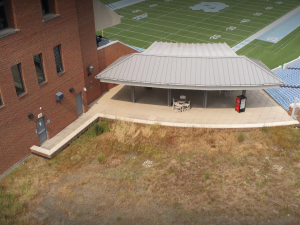
The Loudermilk Center for Excellence’s green roof, installed in 2011, rises above Kenan Stadium. It has a planted roof area of 4,160 square feet and a soil depth of 3-4 inches. You can access the roof by taking the elevator the third floor. Exit onto the concourse and turn right. Before stadium seating begins, at the end of the Loudermilk building, take the external stair case to the fourth floor patio.
Mary Ellen Jones, a LEED Gold building, is located on UNC School of Medicine Campus. Completed in 2019, the 8,400 square foot elevated pedestrian plaza is UNC-Chapel Hill’s newest green roof. Larger shrubs are planted along the sides and in the middle of the plaza, which also offers seating to students, staff and faculty.
Installed in 2005, the 21,920 square foot Rams Head Plaza green roof is an intensive roof with variable soil depth. Sometimes referred to as a rooftop landscape, this green roof gets a lot of student traffic, as it connects south campus to middle and north campus. Similar to Mary Ellen Jones, this green roof is a plaza that gets a great deal of foot traffic. It is highly exposed and contains trees, shrubs and grass. The trees on the roof may get to 40-60 feet tall. Rainwater draining off the roof collects in cisterns located beneath some of the sport fields across the street.
Campus Green Roofs Map
Explore the map to see the locations of our eight campus green roofs, then learn more about them below.

